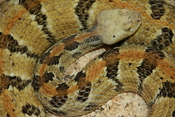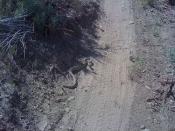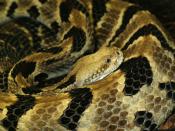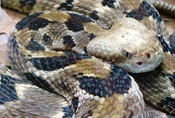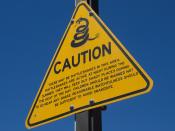The timber rattlesnake is a thick-bodied snake that has two different color variations, which vary depending on how far north, or south the snake is found. The yellow variation has black or brown bands on a yellow, brown or gray background. The bands break up toward the head and form a row of dark spots down the back and each side. The dark variation has a dense speckling of black or dark brown that hides the lighter colors. Timber rattlesnakes also have a diamond-shaped head and either black or dark brown tails.
Timber rattlesnakes can only be found in areas from southern New Hampshire, west through the Champlain Valley, south through the Appalachian and Blue Ridge Mountains, in northeast Texas and north along the Mississippi River to Wisconsin.
Timber Rattlesnakes have now become very uncommon or even nonexistent in many of the southern states that they once occupied in large numbers.
There are a couple of reasons for this. One of the major reasons for their population decline is the loss of their habitat, the deciduous forest, due to the vast expansion of human development. Other reasons are illegal collecting by poachers and indiscriminate killing.
The last limiting factor that has an effect on the timber rattlesnakes' population is the fact that they mature and reproduce very slowly. Timber rattlesnakes take 7 to 10 years to reach sexual maturity, and females only breed every three or four years during the spring or fall. They give birth to an average of 9 hatchlings between August and late September. Because it takes them such a long time to reach maturity, and because of the long periods of time when no breeding takes place, timber rattlesnakes are unable to keep a steady population. More of them die than are born each year.
What can you do to help? In areas where timber rattlesnakes still exist, intensive land development can result in humans and buildings being in the timber rattlesnakes' path of migration. Getting rid of hiding places that could be used by the snakes can discourage their use of your yard. Keep your grass short and remove piles of brush, rocks and logs. Be careful of where you let your pets roam. Usually, the presence of humans is enough to keep snakes away from the area. However, if a snake continues to persist, you can call the Florida Fish and Game Commission to find out about people in your area who are qualified to handle venomous snakes. Do not attempt to remove timber rattlesnakes on your own; they can be very aggressive and, like any other rattlesnake are potentially deadly. Timber rattlesnakes are also protected in Florida as a "Threatened Species"ÃÂ. Therefore, it is illegal to possess, kill, or aggravate a timber rattlesnake. If you observe anyone killing a rattlesnake, report the violation to the Fish and Game Commission.
